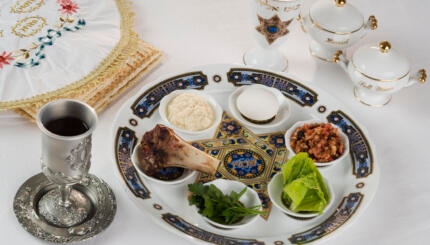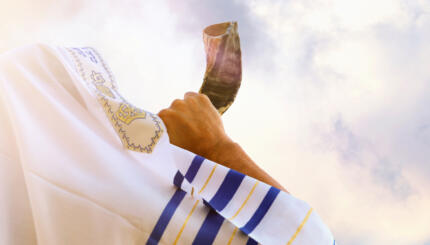The questions asked by the child during the course of the seder meal have been changed over the centuries. The earliest version of these questions was preserved by the Jerusalem Talmud (Chapter 10 of Pesachim). This text contains only three questions, the first one beginning with the Hebrew phrase “mah nishtanah“–why is it different?–which is used in our day as well. In the three questions as reported in the Jerusalem Talmud, the child lists three practices that distinguish Passover night from all other nights:
On all other nights, we dip only once, and on this night, twice.
On all other nights we eat hametz, and on this night, only matzah.
On all other nights we eat roasted or boiled meat, but on this night only roasted.
With your help, My Jewish Learning can provide endless opportunities for learning, connection and discovery.
The first question related to the practice of eating (dipping) herbs twice on the night of Passover. It was an ancient custom to eat herbs after they had been dipped as a type of appetizer. In the Passover ritual, the herbs were dipped twice, once right after the blessing over the wine, in commemoration of the dipping of the hyssop in blood, and the second dipping referring to the bitter herbs that were eaten with the paschal lamb at the conclusion of the meal. Serving the first herbs as a separate dish and not as a course of the meal was an indication to the child that there was something “different” about Passover night.
The second question related to the eating of unleavened bread, and the third question to the paschal lamb, the last dish to be placed on the table.
As of this time, there was no traditionally fixed answer to these questions as was formulated later in the Passover Haggadah. According to the Talmud (Pesachim 116a), the father’s answer was intended to fit the knowledge and understanding of the child.
[When the seder as we know it today took shape, the pattern of this new seder also resulted in the addition of a fourth question and a change in their sequence.] Rabban Gamliel had issued a dictum calling for the interpretation at the seder of the paschal lamb, matzah, and maror. The questions were therefore addressed to these three rituals. Since the paschal lamb was no longer available, preference was given to a new version of the questions:
1. matzah,
2. maror [bitter herbs] (a new question),
3. roast, and
4. double dipping.
The last question, that of double dipping, had originally been the first because it was one of the first differences that a child would have noticed on the night of the seder.
In the Geonic period (6th to 11th centuries), the form of the questions was changed again. The reference to the roasted meat was omitted for lack of a paschal lamb, and a reference to the custom of reclining was substituted in order to preserve the traditional number of questions in vogue during the Talmudic period. Thus, the latest version of the questions is:
1. matzah,
2. maror,
3. double dipping, and
4. reclining.
If you’re looking for the text of the Four Questions, click here
To listen to a recording of the Four Questions, click here
Excerpted with permission from Every Person’s Guide to Passover. (Jason Aronson, Inc).
seder
Pronounced: SAY-der, Origin: Hebrew, literally "order"; usually used to describe the ceremonial meal and telling of the Passover story on the first two nights of Passover. (In Israel, Jews have a seder only on the first night of Passover.)
Talmud
Pronounced: TALL-mud, Origin: Hebrew, the set of teachings and commentaries on the Torah that form the basis for Jewish law. Comprised of the Mishnah and the Gemara, it contains the opinions of thousands of rabbis from different periods in Jewish history.


